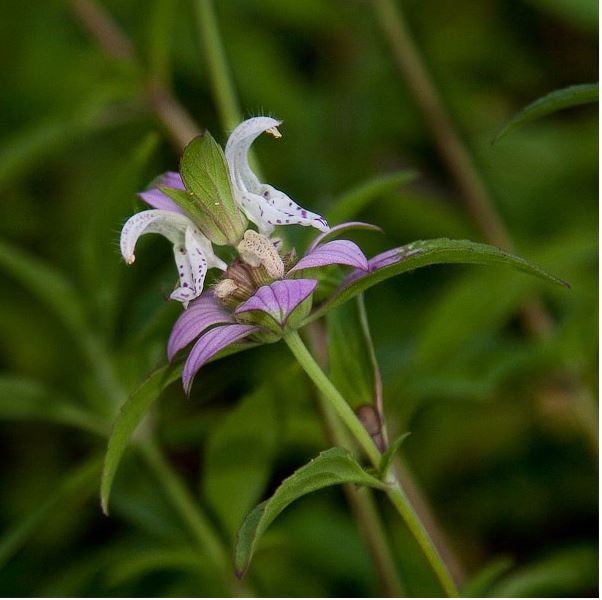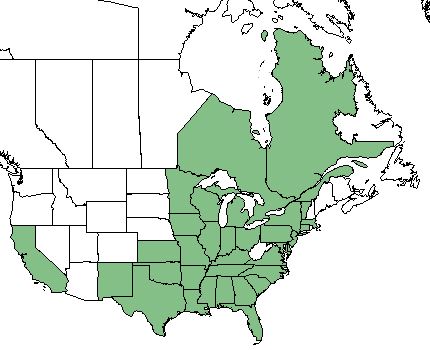Monarda punctata
| Monarda punctata | |
|---|---|

| |
| Photo by John B | |
| Scientific classification | |
| Kingdom: | Plantae |
| Division: | Magnoliophyta - Flowering plants |
| Class: | Magnoliopsida - Dicots |
| Order: | Lamiales |
| Family: | Lamiaceae |
| Genus: | Monarda |
| Species: | M. punctata |
| Binomial name | |
| Monarda punctata L. | |

| |
| Natural range of Monarda punctata from USDA NRCS Plants Database. | |
Common Names: Arkansas horse-mint, eastern horsemint, hairy-stem horsemint, western horse-mint, plumetooth beebalm, east Texas horesemint, Tamaulipan horsemint,[1] spotted beebalm[2]
Contents
Taxonomic Notes
Synonyms: Monarda punctata ssp. punctata var. correllii; M. punctata ssp. punctata var. intermedia; M. punctata ssp. punctata var. punctata; M. arkansana; M. punctata ssp. arkansana McClintock & Epling; M. punctata ssp. punctata var. arkansana (McClintock & Epling) Shinners; Monarda punctata Linnaeus var. arkansana (McClintock & Epling) Shinners; Monarda punctata ssp. punctata var. occidentalis; M. punctata var. occidentalis; M. punctata ssp. punctata var. villicaulis (Pennell) Palmer & Steyermark; M. punctata ssp. villicaulis Pennell; Monarda punctata Linnaeus var. villicaulis (Pennell) Palmer & Steyermark[1]
Varieties: Monarda punctata Linnaeus var. correllii; M. punctata Linnaeus var. intermedia (McClintock & Eplinag) Waterfall; M. punctata Linnaeus var. lasiodonta A. Gray; M. punctata Linnaeus var. punctata; M. punctata var. coryi[1]
Description
M. punctata is a dioecious species, classified as an annual, biennial, and perennial. It grows as a forb/herb or subshrub.[2] It is an aromatic species that reaches heights of 1-3 ft (0.30-0.91 m). Inflorescence are tubular and yellowish/purple spotted, occurring in whorls that form a dense elongated spike at the end of the stem or leaf axil. It also has bracts that can be purple, pink, white, or yellow.[3]
Var. villicaulis has a lower leaf surface that is moderate to densely silvery-tomentose and a stem with densely villous with spreading or downwardly-curved coarse hairs. Var. arkansana and var. punctata both have a lower leaf surface with pubescence mainly on the midvein and other main veins and stem pubescence with curved hairs. Var. arkansana is distinguishable by the short, horizontal or downward-curving hairs on its stem and leaves which are 50-70 mm long and 10-28 mm wide. Var. punctata has a stem with upwardly-curving and downwardly-curving bristles, though it has few or no horizontal bristles. Its leaves are 35-55 mm long and 5-17 mm wide.[1]
Distribution
This species is found from New Mexico and Kansas, eastward to Florida, northward to Vermont and Massachusetts, and inland to Iowa and Minnesota. Exceptions to this are Delaware and West Virginia, where no mounted specimens have been reported to the USDA. It also occurs in the Canadian provinces of Ontario and Quebec and has a disjunct population in California.[2]
Var. arkansana is often considered as a southwest endemic, particularly in Arizona and Texas, though specimens have been collected in North Carolina and Georgia. Var. punctata ranges from New Jersey to southern Florida and west to Texas. This variety is restricted mainly to the Coastal Plain but extends inland southward. Var. villicaulis ranges from New York, west to Minnesota, and south to Tennessee, Arizona, and Oklahoma.[1]
Ecology
Habitat
M. punctata has been found in wax myrtle thicket, oak woods, marshes, longleaf pine-wiregrass stands, dirt mounds, and upland pinewoods.[4] It is also found in disturbed areas including horse pastures, burned pinelands, corn patch edges, railroads, old fields, drainage ditches, picnic areas, rock quarries, and roadsides.[4] Associated species: Solidago, Solidago tortifolius, Chamaecrista nictitans, Oenothera biennis, Lespedeza stuevei, Tridens flavus, and Eragrostic.[4] M. punctata occurs in dryish forests over mafic rock, maritime forests, dunes, roadsides, rocky or sandy woodlands, and disturbed areas.[1] In Wisconson 25 year old fields, M. punctata had higher frequency and percent cover (1.15%) in open fields than under or near the canopy of Quercus ellipsoidalis (0.15% cover).[5]
Phenology
In the southeastern and mid-Atlantic United States, flowering occurs from July through October.[1] In the Florida panhandle, flowering has been observed in September and October.[6] In Texas, this species grows from January through April, booms from May through June, matures its seeds from early June through mid-July, and disseminates its seeds from mid-July through mid-September.[7]
Fire ecology
Populations of Monarda puncata have been known to persist through repeated annual burning.[8]
Pollination
Monarda punctata is insect pollinated and is of special value to native bees, bumble bees, honey bees, butterflies (including the endangered Karner blue butterfly, Lycaeides melissa samuelis[9]), and predatory and parasitoid insects that prey upon other insects.[3] When blooming in Wisconsin, pollinator visits occurred up to 1.1 visits min-1.[10] Additionally, M. punctata has been observed to host leafcutter bees such as Megachile frugalis (family Megachilidae), bees from the Andrenidae family such as Perdita gerhardi, P. jonesi, and Protandrena abdominalis, and sweat bees from the Halictidae family such as Lasioglossum imitatum, L. pilosum, and L. vierecki.[11]
Herbivory and toxicology
M. punctata composes 5-10% of the diets of large mammals.[12] It is also found in about 25% of the crops of mourning doves (Zenaida macroura)[13] and 28% of the crops of scaled quail (Callipepla squamata)[14] in southeastern New Mexico. Small rodents, including Ord's kangaroo rats (Dipodomys ordii), consume seeds of Monarda punctata.[15]
Conservation, cultivation, and restoration
Cultural use
Photo Gallery
References and notes
- ↑ 1.0 1.1 1.2 1.3 1.4 1.5 1.6 Weakley, A.S. 2020. Flora of the Southeastern United States. Edition of 20 October 2020. University of North Carolina at Chapel Hill, Chapel Hill, North Carolina.
- ↑ 2.0 2.1 2.2 USDA NRCS (2016) The PLANTS Database (http://plants.usda.gov, 29 January 2018). National Plant Data Team, Greensboro, NC 27401-4901 USA.
- ↑ 3.0 3.1 Plant database: Monarda punctata. (29 January 2018) Lady Bird Johnson Wildflower Center. URL: https://www.wildflower.org/plants/result.php?id_plant=MOPU
- ↑ 4.0 4.1 4.2 Florida State University Herbarium Database. URL: http://herbarium.bio.fsu.edu. Last accessed: June 2021. Collectors: Loran C. Anderson, R. F. Doren, L. S. Gill, Robert K. Godfrey, R. Komarek, Travis MacClendon, K. MacClendon, John B. Nelson, Julie Neel, R. A. Norris, Eddy Reid, Terri Reid, Amy Reid, and Cecil R Slaughter. States/countries and counties/parishes: Florida: Calhoun, Franklin, Hamilton, Leon, Volusia, Wakulla, and Washington. Georgia: Thomas. South Carolina: Calhoun. Canada: Ontario.
- ↑ Whitford PC, Whitford PB (1978) Effects of trees on ground cover in old-field succession. The American Midland Naturalist 99(2):435-443.
- ↑ Nelson, G. PanFlora: Plant data for the eastern United States with emphasis on the Southeastern Coastal Plains, Florida, and the Florida Panhandle. www.gilnelson.com/PanFlora/ Accessed: 29 JAN 2018
- ↑ Chenault TP (1940) The phenology of some bob-white food and cover plants in Brazos County, Texas. The Journal of Wildlife Management 4(4):359-368.
- ↑ Platt, W.J., R. Carter, G. Nelson, W. Baker, S. Hermann, J. Kane, L. Anderson, M. Smith, K. Robertson. 2021. Unpublished species list of Wade Tract old-growth longleaf pine savanna, Thomasville, Georgia.
- ↑ Grundel R, Pavlovic NB, Sulzman CL (2000) Nectar plant selection by the Karner blue butterfly (Lycaeides melissa samuelis) at the Indiana Dunes national Lakeshore. The American Midland Naturalist 144(1):1-10.
- ↑ Rafferty NE, Ives AR (2011) Effects of experimental shifts in flowering phenology on plant-pollinator interactions. Ecology Letters 14:69-74.
- ↑ Discoverlife.org [1]
- ↑ Miller JH, Miller KV (1999) Forest plants of the southeast and their wildlife uses. Southern Weed Science Society.
- ↑ Best TL, Smartt RA (1986) Feeding ecology of mourning doves (Zenaida macroura) in southeastern New Mexico. The Southwestern Naturalist 31(1):33-38.
- ↑ Best TL, Smartt RA (1985) Foods of scaled quail (Callipepla squamata) in southeastern New Mexico. Texas Journal of Science 37(2&3):155-162.
- ↑ Best TL, Skupski MP, Smartt RA (1993) Food habits of sympatric rodents in the shinnery oak-mesquite grasslands of southeastern New Mexico. The Southwestern Naturalist 38(3):224-235.